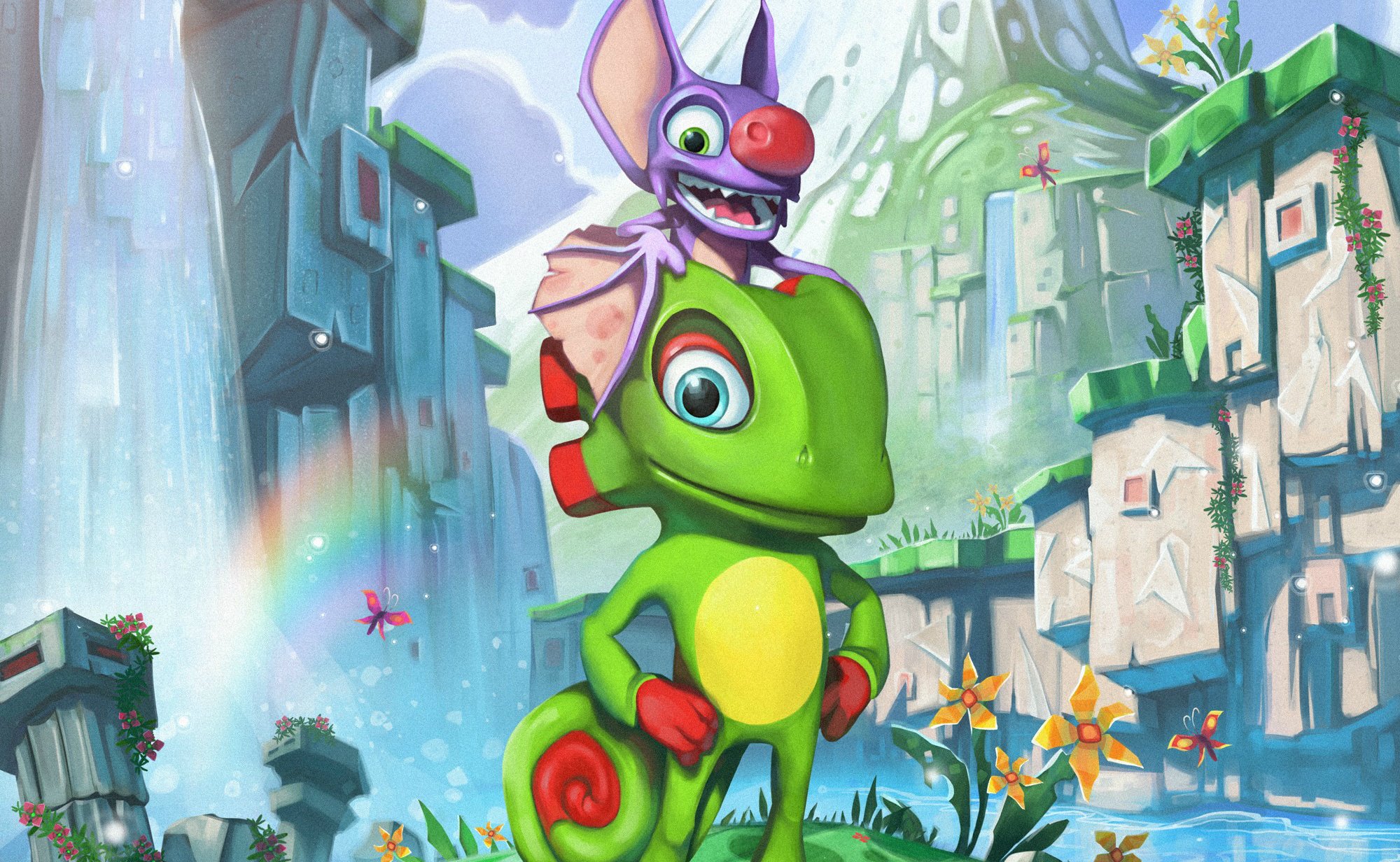When looking back on the classic catalogue of Rare games, few are as readily recalled and beloved as Banjo-Kazooie, along with its equally beloved sequel, Banjo-Tooie. Considered to be two of the Nintendo 64’s top defining classics, both games have since seen re-releases on Xbox 360, and on Xbox One via the jam-packed Rare Replay compilation, keeping them readily available in the modern gaming market, at least for Xbox gamers. Even then though, we never got a ‘Banjo-Threeie‘, as it were (the oft-mocked Xbox 360 offshoot, Banjo-Kazooie: Nuts & Bolts doesn’t count!), leaving a gag foreshadowing in the ending of Banjo-Tooie to remain unanswered for the foreseeable future.
Well, thank goodness for Kickstarter then, and an entire internet community starved for a true follow-up to the duo of Banjo-Kazooie games! One successful crowdfunding campaign later, spearheaded by Playtonic Games, a studio founded by ex-Rare employees no less, and we have Yooka-Laylee! Similar to the upcoming Bloodstained: Ritual of the Night and the infamously failed Mighty No. 9, Yooka-Laylee wears its nostalgic inspiration on it sleeve, essentially being a thinly-disguised Banjo-Threeie masquerading as an all-new IP. For better or worse, this is the true Banjo-Kazooie threequel that we never got from Rare, which is sure to overjoy folks who grew up collecting Jiggies and Jinjos.
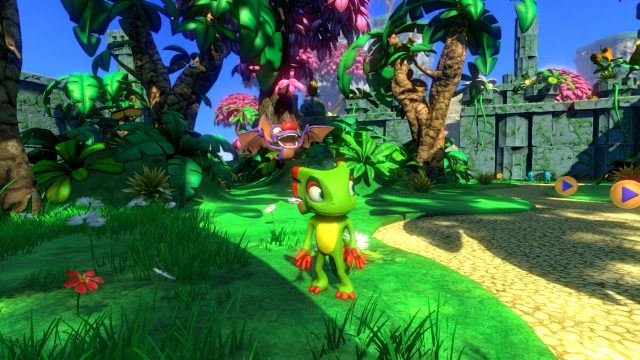
The bigger question though is whether Yooka-Laylee can effectively translate to a modern gamer’s tastes. Nostalgic gamers will definitely eat it up, especially since the game is leaps and bounds better than Mighty No. 9 in its final product, even if it still doesn’t quite measure up to Kickstarter-funded, nostalgia-motivated darlings like Shovel Knight, Undertale or Pillars of Eternity. Despite its friendly, colourful exterior though, Yooka-Laylee definitely isn’t for everyone, since it holds itself up on intentionally dated gameplay and a whole lot of collectibles, two things that many modern gamers tend to take issue with. If you want a charming and well-produced blast from the past however, and can put up with some of the backwards design, Yooka-Laylee does a pretty good job of taking you back to a bygone era of gaming.
Yooka-Laylee is a great testament to the kind of visual power you can wring out of the Unity Engine, when it’s utilized well. The game is very colourful and wonderfully detailed, with level landscapes unfolding like intricate plasticine creations, in turn arranged with imaginative, often unexpected combinations of environmental features. One world for example blends snow-covered drifts and a large frozen lake with a glistening ice castle on one end, and a network of frigid stone towers on the other. Another world meanwhile presents vast, putrid swampland, with certain corners being more developed and industrialized, while others are creepily foreboding and seemingly haunted. The hodgepodge of toybox-style world details is one of many elements clearly lifted from the Banjo-Kazooie design template, but it still presents a way to constantly be surprised by the visual flourishes, personalities and other such features that effectively bring each world to life.
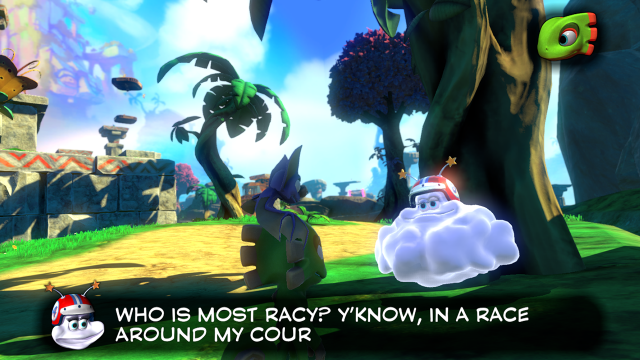
You can obviously wring a bit more visual power out of the game if you’re playing on a high-end PC too, though even on consoles, Yooka-Laylee looks very impressive, and generally runs pretty well. The Unity Engine can be a bit less reliable on consoles though, which results in some framerate hitching and a bit of slowdown during instances of busy environmental rendering in the case of Yooka-Laylee, but it’s never bad enough to extensively disturb the game experience.
Be advised though that only PC players will have the option of cranking the framerate further, with console players stuck at a cap of 30fps, a limit that will seemingly always be in place on Xbox One (and likely the forthcoming Nintendo Switch build), even if the PS4 version is allegedly preparing a patch to boost performance when Yooka-Laylee is played on a PS4 Pro. Load times are a tad long when you’re moving between worlds too, or even key sections of the intricately detailed hub area, Hivory Towers. Considering how much ambitious visual design has to be rendered for this modestly-budgeted indie game however, that’s an acceptable concession for how gorgeous the world of Yooka-Laylee often looks.
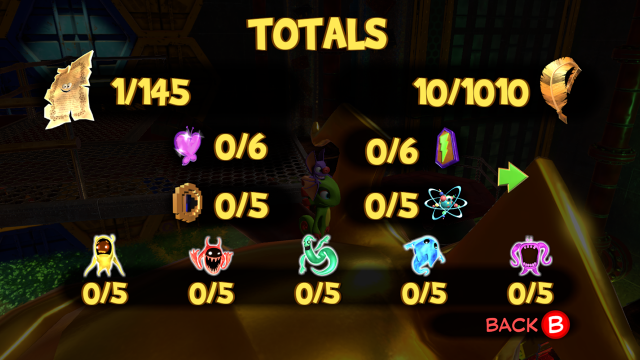
The game’s camera, meanwhile, is a little bit harder to deal with in certain sections of the game. Yooka-Laylee generally lets players control the camera themselves, using the usual right stick method, but there’s times where the game will wrestle camera control away from the player, with no logical motivation. Sometimes, this is fine, such as moments where a top-down view is employed in a high-up area to give you a better view of your surroundings. Other times though, the camera will swing around and spin on its own, seemingly at random, and especially when you’re in confined spaces. This is frustrating during time-sensitive challenges especially, since you will sometimes have to wrestle with the camera when you should be focused on precision navigation and platforming. Even the first-person view, triggered by pressing in the left stick, can be fussy at times, and arbitrarily doesn’t work in certain sections. Again, this doesn’t happen often enough to disturb the game experience, but it’s very annoying when it does happen.
Rare has a long history of great soundtracks across their various classics, and this is another welcome element of inspiration taken in Yooka-Laylee by Playtonic Games. Yooka-Laylee’s fun, lively and catchy soundtrack is an excellent throwback to the Nintendo 64 days, with the music yet again taking a cue from Banjo-Kazooie through its composition and tempo changes, changing in style depending on which part of the world environments you’re exploring. Different sound effects and musical speeds for each area of a world help to enhance the atmosphere of the game even further, blending well with the standout visual design to create a throwback game with an astonishing amount of modern polish in its presentation. Best of all, Yooka-Laylee even brings back Banjo-Kazooie composer, Grant Kirkhope to score the music of the game, something that should be very exciting to retro gaming fans!
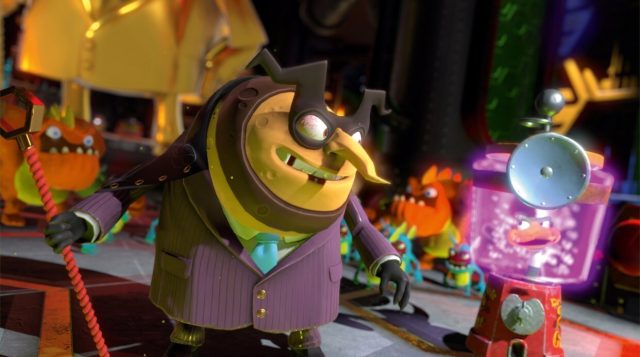
The cartoon-ish, zany sound effects in Yooka-Laylee also feel ripped straight from a Nintendo 64-era mascot platformer, only updated with clearer modern audio sensibilities. The sound effects of your various power-ups add a lot of charm to both combat and exploration, just as the satisfying audio cues unique to each collectible will give you a sense of heartwarming accomplishment for every one you get your hands on. Even the gibberish-style character voices that play over text boxes, a staple of Nintendo 64-era games like Banjo-Kazooie, are back to sustain Yooka-Laylee’s dialogue. As with the game design itself, some may find these gibberish voices annoying, but for others, they’re a fun and comforting callback to a time before mascots had to use their words like everyone else.
Describing how to play Yooka-Laylee is practically redundant, since, if you’re at all familiar with Banjo-Kazooie, or other collect-a-thon style 3D platformers of the late 90’s, then you should already know how to play it. The object of the game is to proceed through a selection of ‘Tome Worlds’, all hidden in a grand and detailed hub area, Hivory Towers, which has its own secrets and collectibles to discover. Each of Yooka-Laylee’s Tome Worlds requires players to get their hands on Pagies (standing in for Banjo-Kazooie’s Jiggies), missing pages from a great book that has been stolen by the game’s villain, Capital B. You’ll also need to be on the lookout for other collectibles as well, such as Quills, which are used as currency to buy new moves from shifty snake salesman, Trowzer, Mollycools, which can be given to a squid scientist named Dr. Puzz to transform Yooka and Laylee into alternate forms (reminiscent of Mumbo Magic from Banjo-Kazooie), and Ghost Writers, five of which are hidden in each stage, much like Banjo-Kazooie’s Jinjos.

In case it’s not obvious already, Yooka-Laylee is practically indistinguishable from Banjo-Kazooie in terms of its gameplay fundamentals. Even its inter-species duo of protagonists have similar personalities as Banjo and Kazooie before them. Yooka is a heroic, altruistic chameleon who is always happy to give other characters a hand, and conquer whatever challenges are in the way to his making the world a better place. Laylee, meanwhile, is a cynical, sarcastic and often exasperated bat who loves to complain and mock the world around her, often breaking the fourth wall in turn to make cracks about modern gaming frustrations like microtransactions and DLC (something other NPC’s frequently do as well), despite Yooka doing most of the work in gameplay. These two manage to be lovable and fun characters in their own right, even if, between their dialogue and abilities, it’s very obvious which well-known Nintendo 64-era gaming icons they’re trying to emulate.
To be fair though, Yooka-Laylee does at least have some of its own interesting ideas sprinkled throughout the gameplay, which avoid the feeling of it being a complete knock-off of Banjo-Kazooie. Yooka, for example, can use his tongue to gobble up special berries that can temporarily allow him to do things like spit fire, spray water, or even lob explosives, which can be used for both combat or solving puzzles. You can even upgrade this ability to have Yooka completely take on the traits of something he licks, such as turning him into metal to avoid being blown around by strong winds, or turning him to honey so that he doesn’t slide on ice. Another example of a unique gameplay feature is Laylee eventually getting the ability to use bat sonar, which can initially be used to reveal hidden paths by awakening totems, and can later be powered up as a huge blast that can both shatter glass and obliterate enemies!
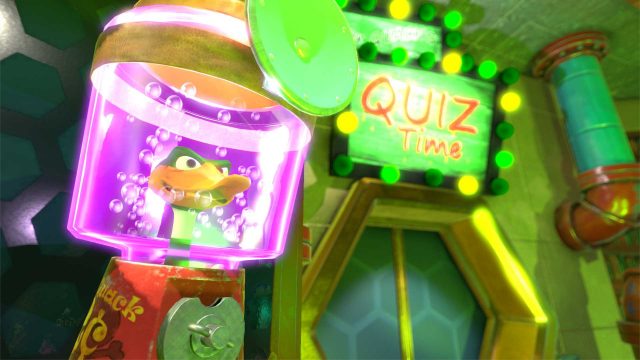
By far the coolest and most interesting new idea behind Yooka-Laylee however is the chance to spend Pagies to expand Tome Worlds that you’ve already been to. The game disappointingly only contains five Tome Worlds total, plus the Hivory Towers hub area, which is one place where its Kickstarter-funded budget becomes pretty evident. Still, the chance to expand these worlds creates not only more opportunities to amass Pagies and other collectibles, but also discover new locations and challenges. Expanding the initial tropics area for example opens a way to a treacherous temple, among other new locations, while expanding the subsequent ice-themed world will open up the previously locked ice castle, a place filled with its own all-new tricky traps and puzzles. More worlds would have been appreciated, but at least the world expansion idea feels novel, and is a fairly clever way to get around some of Yooka-Laylee’s budget constraints.
As neat as it is to discover new challenges and further open up worlds though, expanding worlds often only exacerbates a problem that some players will run into pretty quickly; It can be pretty easy to get lost in some of Yooka-Laylee’s various areas. The scale of each world is very impressive, but the lack of rhyme and reason to the world design means that it’s easy to get turned around and lose your way in most cases, even from the very first world. You’ll eventually learn to recognize landmarks and pathways with enough exploring, but not everyone will have the patience to really get to know each world to this degree.
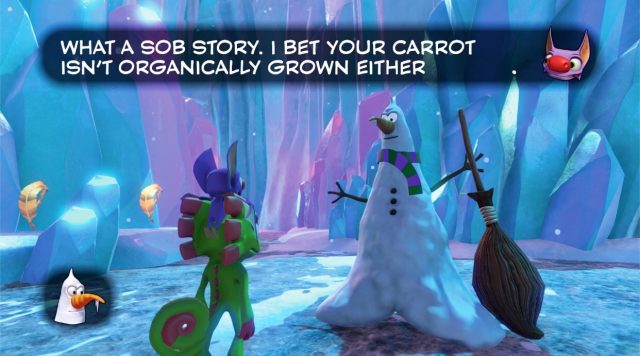
There’s a demand for long-term gratification in the exploration of Yooka-Laylee that was fairly ubiquitous during the Nintendo 64 era, but has become somewhat lost in the modern era. Thus, if you’re used to modern games, which often point you exactly where you need to go to keep the pace flowing, Yooka-Laylee may frustrate you, since it never points you to any specific destination or goal, and forces you to stumble to the next location and the next Pagie on your own wits. By that some token though, nostalgic gamers who don’t mind a game that doesn’t hold your hand may actually appreciate the fact that Yooka-Laylee never gives you any hint as to where you’re supposed to go or what you’re supposed to do, making progression more satisfying to deduce and earn for yourself.
The nostalgic audience may also get a kick out of Rextro’s Arcade, a set of arcade-inspired minigames that can net you more Pagies if you find a Play Coin and bring it to Rextro in each world. If you’re so inclined, you can also access Rextro’s Arcade right from the game’s main menu, allowing up to four players to enjoy some adequate side distractions together, albeit only locally. These include a game where you have to swat away enemies while grabbing as many Quills as possible upon an icy platform, a game where you try to shoot any enemies in your way while automatically moving forward, and a game where you have to race around a track with R.C. cars, avoiding obstacles and edges, and complete a requisite amount of laps before your opponents, among a few other options. Some of Rextro’s minigames are more fun than others, especially when you have to play through some of them more than once for separate Pagies in the main game, but at least they make for a decent way to goof off with your friends, or mix up the fundamental gameplay of the core adventure.
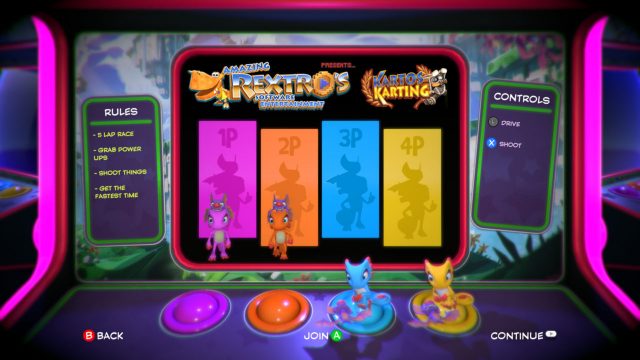
Even if you don’t have a taste for a certain kind of challenge though, assuming you’re not actively going for every achievement/trophy and 100% completion stats, you can at least take comfort in knowing that you’re never locked into any one way to earn Pagies and accomplish challenges. Despite some of its design stumbles, Yooka-Laylee does at least boast an impressive amount of variety in its world progression and Pagie obstacles. If you, for example, can’t stand the painstaking mine cart challenges of Kartos in each world (which feel like a pretty clear throwback to similarly punishing sections in Rare’s Donkey Kong Country games), you can avoid them. Likewise, if you don’t want to deal with Rextro, there are plenty of other ways to amass the requisite Pagies that you need to at least see the end of the game.
Some gameplay annoyances however, you won’t be able to do much about. One particularly troublesome gameplay element is Dr. Quack’s Quickfire Quiz, which feels like a throwback to the annoying Grunty’s Furnace Fun challenge from Banjo-Kazooie, in that Capital B’s number-two henchman, Dr. Quack will ask you multiple-choice trivia questions about Yooka-Laylee. It seems straightforward, but answering a lot of these questions correctly often amounts to blind luck, since they force you to recall obscure environment and NPC details, or be intimately apprised of your gameplay stats on a constant basis, which isn’t fun, and only serves to waste your time.
Likewise, as I said regarding the world design, Hivory Towers doesn’t point you to where you need to go when it comes to finding the next world either. Thus, a surprising chunk of Yooka-Laylee’s 15-20-hour main adventure will consist of you bumbling around the hub area’s latest stretch, looking for some hidden path or door that’s supposed to take you further in the game. Trowzer’s paid abilities, not just the ones he grants you for free in Hivory Towers, are also often necessary to access certain areas, something that Yooka-Laylee seems to actively downplay, despite it being a crucial part of game progression.
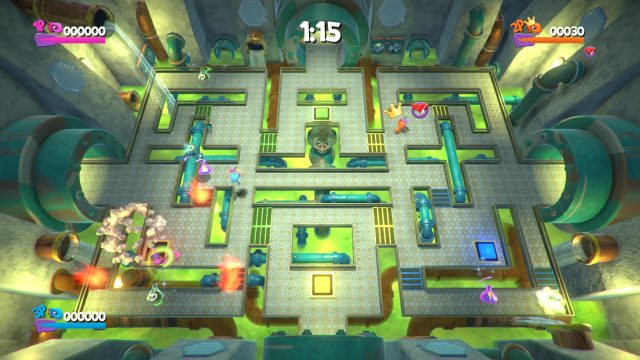
If you still fondly revisit Nintendo 64-era adventuring with a smile though, then these quibbles are probably par for the course for you. If you do find yourself sucked into the adventure of Yooka-Laylee on this basis, you will also enjoy coming back to amass every Pagie, Quill, Ghost Writer and whatever else too, especially when you can access and enable cheat-like Tonics for accomplishing certain play feats, which let you activate bonuses such as negating falling damage, making your stamina drain slower, or allowing you to sense when rare items are nearby. One of these Tonics even lets you play on a significantly more challenging difficulty setting after you initially complete the main story progression to boot, if you really want to push your skills to their limits!
That’s the tricky thing about Yooka-Laylee though. Much like its Nintendo 64 inspirations, its winning charm and cute appearance will draw you in, but its surprising difficulty, demanding collectibles and complete lack of hints and directions will irritate some players, even as they entertain others. If you enjoy taking your time exploring intricate worlds and finding all of their secrets, then you will have lots of fun with Yooka-Laylee, even if you’ll probably also wish that there were more than a mere five worlds. Consequently though, if you subscribe to a more modern gaming sensibility of games being story-driven, focused and consistently exciting, then Yooka-Laylee will come off as a frustrating relic, a monument to why certain things are better left in the past. The old adage really does sum it up best in this case; One man’s trash is another man’s treasure.
Even to the nostalgic player base that will no doubt receive it best, Yooka-Laylee isn’t tightly-designed or groundbreaking enough to be another instant classic akin to Banjo-Kazooie. When compared to more contemporary 3D platformers such as the Ratchet & Clank remake, Tearaway, and no doubt the upcoming Super Mario Odyssey, Yooka-Laylee is more good enough than truly great, even if it’s also a clear cut above, say, the various LEGO platformers. The game isn’t for everyone though, and if you feel that you’ve firmly moved on from the Nintendo 64 days, then Yooka-Laylee won’t have much to offer you.
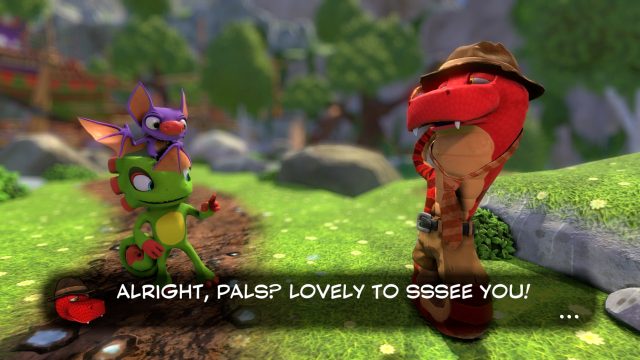
For starved fans of collection-based 3D platformers however, Yooka-Laylee is a pleasing oasis within a seemingly endless desert. It’s always tough to see certain game foundations get abandoned in the so-called name of progress, and sometimes, that does lead to the unfortunate burying of functional game genres that get left behind in the name of the next industry hook. Yooka-Laylee certainly won’t trigger a mass revival effort for its largely dormant subgenre of platformer, but it’s enjoyable comfort food for those people that long for the days of cute mascot heroes and collectible-driven progression, even if the bulk of the game’s appeal seems mostly limited to them.
This review is based on an Xbox One copy of, “Yooka-Laylee”, provided by Team17

